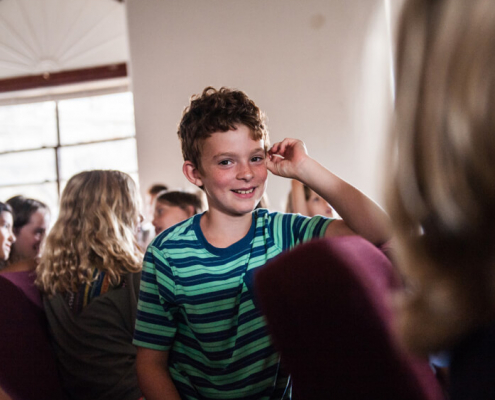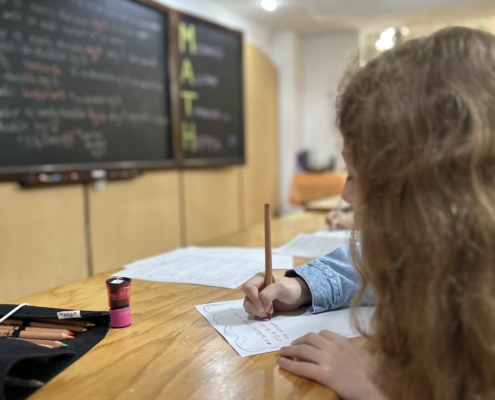Excerpted from Understanding Waldorf Education: Teaching from the Inside Out by Jack Petrash written by the Waldorf School of Orange County
Reading time: 12 minutes
Good Habits of Mind
In high school this three-dimensional paradigm continues to be the guiding educational principle. Waldorf high school students are engaged through the week actively, emotionally and thoughtfully, just as they were in their earlier education. However, during this third phase of a young person’s education, the emphasis in a Waldorf high school moves decidedly toward thinking, which is developed through the types of subjects that are taught and through the habits of mind that are cultivated.
The maturation process that occurs in high school students plays an important role in determining which habits of mind will be cultivated during the four years. According to Douglas Gerwin, the director of the Waldorf High School Training in New Hampshire, each high school year should present a unique question to the students. These underlying questions have important purpose, to awaken specific aspects of human intelligence.
Ninth grade students are summoned to exercise powers of exact observation: in the sciences, to describe and draw precisely what happened in the lab experiments and demonstrations; in the humanities, to recount clearly a sequence of events or the nature of a character without getting lost in the confusion of details. The objective here is to train in the student powers of exact observation and reflection so they can experience in the raging storm of phenomena around them the steady ballast of their own thinking…One may summarize the approach of this freshman curriculum with the seminal question: What? What happened? What is going on here? What did you see and hear? (Gerwin, 1997, p. 12)
Gerwin goes on to say that in tenth grade, observation is expanded to include comparison and the question of “What?” is replaced with “How?” How are acids different from bases? How are men different from women? How do cultural and religious traditions from the Middle East and the Far East differ from those in the West?
Eleventh grade develops powers of analysis and abstraction. Gerwin continues: the junior year curriculum could be characterized by a theme of invisibility. Namely the study of those subjects that draw the student into areas that are not accessible to the experience of our senses…In chemistry, the students enter the invisible kingdom of the atom; in physics they explore the invisible world of electricity (which we can see only in its effects, not in its inherent nature)…These voyages to the invisible landscapes pose a central question intended to strengthen the student’s powers of independent analysis and abstract theorizing. The question is “Why? Why are things this way?” (Gerwin 1997, p. 13, 14).
Although the development of thinking is certainly not completed in the high school and will continue in college and in life, the twelfth grade is a time to step back and observe the whole. Synthesis becomes the habit of mind that is trained as the students are asked to broaden their view and see their subjects as part of a whole curriculum. The curriculum poses the questions — “How do I see the world in a non-fragmented way?” “Is there meaning in life?” and finally, “Who am I?” These are presented to the seniors as they look back on their years of study. These questions are raised repeatedly, particularly in the literature study of the transcendentalists, with Emerson’s “Self Reliance,” Walt Whitman’s “Song of Myself” and with Emily Dickinson’s poem, “The Inner from the Outer.”
Keeping those underlying questions in mind, teachers help to develop powers of discernment, enabling students to look closely at the world in which they live and at themselves. The ability to observe, compare, analyze and synthesize helps young people better understand the world they are inheriting and at the same time, prepares them for finding their place in the world. Because Waldorf education requires inner responsiveness on the part of the students, graduates leave school with a clearer sense of who they are and what they believe to be important, making it possible for them to give direction in their own lives.
In-Depth Study
To develop good habits of mind, schools create learning situations that encourage students to explore subjects deeply, going beyond a superficial understanding. This requires a more intensive focus and in-depth study.
Tod Sizer, the founder of the Coalition for Essential Schools at Brown University, contends that it is not effective to try and cover all the material specified in high school curricula because such attempts to teach all areas of study lead only to a smorgasbord of superficial instruction. “My basic conclusion is contained in the aphorism ‘less is more.” I believe that the qualities of mind that should be the goal of high school need time to grow and that they develop best when engaging a few, important ideas, deeply” (Sizer, 1992 p. 89).
Rather than sampling a wide range of diverse material, Waldorf schools choose to delve deeply into selected areas in an effort to provide their students with a more substantive understanding. The main lesson classes that are taught in the high school take place in an hour and forty minute “double” period at the beginning of each school day over the span of three to four weeks. This “block scheduling,” which is also a school reform used in mainstream education in both high schools and colleges, is an organizational feature well suited to in-depth study. A dozen subjects are studied in this way over the course of each year. These subjects come from all disciplines ranging from science and math to the humanities and are taught in an intensive, concentrated manner.
Maine Coast Waldorf School
Truth, Beauty and Goodness
The subjects that a school elects to offer express the values of its institution and/or its school system. This is certainly the case in the Waldorf high school, which subscribes to a value-laden approach, one similar in sentiment to what Howard Gardner expresses in his book, The Disciplined MInd: “an education for all human beings needs to explore in some depth a set of key human achievements capture in the venerable phrase “the true, the beautiful and the good” (Gardner, H., 2000, p. 19).
For Rudolf Steiner, the experience of truth, beauty and goodness was an essential aspect of what children should receive in school. This also is an apt way to describe what Waldorf high school students will encounter through the curriculum. The subjects that are taught can essentially be organized around these ideals.
Truth
High school students actively take up a search for truth. Math and science subjects such as Boolean Algebra, Permutations and Probability, Geology, Optics or Zoology provide necessary understandings about the tangible world and foster the mental acuity needed for this exploration. But a search for truth is also a personal quest for each individual student. That is why teenagers begin to question adults rather than simply to ask questions. A search for truth inevitably requires that both students and teachers are able to suspend personal beliefs and for an extended period of time entertain other points of view. Today, more than ever, issues are rarely so clear as to be one sided. High school teachers must help students develop the habit of considering issues from various points of view.
History teaching in the high school can further this effort by presenting many sides of an issue. With the Civil War, for instance, students can understand both the outrage of northern abolitionists and the “love of place” that motivated Virginians and especially Robert E. Lee. Students need to experience the worry and danger of the Underground Railroad, as well as the apprehension and pain of the battlefield, the sadness and discouragement of Abraham Lincoln, Daniel Webster, or even Jefferson Davis, and the heartache of the mothers and wives back home. They should know the desolation and shock of the people of Georgia as Sherman made his “March to the Sea” and they should comprehend as well the disappointment caused by the assassination of Lincoln. Young people must see that event with clear issues, a search for truth is complicated and time consuming, but always worth the effort.
Beauty
The Waldorf curriculum also provides its high school students with the opportunity to consider timeless beauty. In freshman and sophomore year, the study of Art History, a two-part survey course, enables the students to experience, know, and recreate works of lasting artistic value. The eleventh-grade study of the History of Music offers the same opportunity, as does the senior-year study of the History of Architecture. All of these courses underscore the importance of beauty and place it in the context of human history.
Goodness
High school students also need an experience of the good. The National Association of Secondary School Principles (NASSP) states in its report, Breaking Ranks: Changing an American Institution, “that schools must unabashedly teach students about key virtues…Some educators may feel uncomfortable about accepting this assignment, but we believe certain enduring virtues are universal to principled Americans. In an era where children are killing children and children are giving birth to children, high schools cannot afford to shirk this duty” (NASSP 1996a, p. 30).
Value-laden instruction is a complicated matter fraught with a wide array of difficulties, but one that cannot be avoided. Although it is often fruitless to provide direct instruction about virtue, examples of individuals from history and literature who have wrestled with moral questions enable students to explore and define their own beliefs. In high school, the main lesson in Dante’s Inferno brings students face to face with the conflict of Good and Evil. In the study of the epic tale, Parsifal, the role of personal moral responsibility is explored. And the reading of Victor Hugo’s classic novel, Les Miserables, the possibility of human transformation is viewed through the character of Jean Valjean. Other books such as the Upanishads or the Bhagavad Gita are used in a Waldorf high school because they raise serious ethical questions, ones that encourage students to consider goodness as an ideal that is worthy of our attention as truth and beauty.
The Pedagogy at Work
In a freshman class at Oberlin College in Ohio, students are receiving an unexpected and rather surprising assignment. The professor tells them that he is going to collect their notes at the start of the next day’s class. After a flurry of gasps and groans, one student asks, “Which notes?”
“Your class notes,” the professor replies.
“But which class notes?” the student responds, “The ones I take each day or the ones that I rewrite at night?” Now it is the professor who is surprised. “Who told you that I was going to collect your notes?”
“No one,” the student rejoins, “this is the way I was taught to take notes.” “Where did you go to school?” the professor asks skeptically.
The student answers, “A small school on Long Island, the Waldorf School.” “Oh, that explains it,” the professor replies, satisfied at last.
The value of the Waldorf educational philosophy should be evident in its ability to put educational principles into practice. One way to assess if this is indeed being done effectively would be to examine the Waldorf program in the light on commonly accepted educational criteria.
The late Ernest Boyer, former Commissioner of Education, Chancellor of the State University of New York, and president of the Carnegie Foundation for the Advancement of Teaching, took part in an extensive study of secondary education in America and proposed that high schools should strive to meet four essential goals.
First, the high school should help all students develop the capacity to think critically and communicate effectively through a mastery of language.
Second, the high school should help all students learn about themselves, the human heritage, and the interdependent world in which they live through a core curriculum based upon consequential human experiences common to all people.
Third, the high school should prepare all students for work and further education through a program of electives that develop individual aptitudes and interests.
Fourth, the high school should help all students fulfill their social and civic obligations through school and community service (Boyer, 1983, p. 66-67)
These four goals provide a viable way to measure the soundness of the Waldorf approach to high school education.
Communicating Clear Thinking through the Mastery of Language
With regard to the first of Boyer’s goals, the section of this chapter that discusses good habits of mind (pages 84-87) shows that Waldorf high schools offer a comprehensive approach to the development of critical thinking. What has not been stated explicitly, however, is the role that the mastery of written and spoken language plays in that process.
Each high school student writes, on the average, three compositions each week. These pieces vary in type from experiment observations, to informative descriptions, to narrative accounts, essays, research projects and literary interpretations. Almost all of these compositions will become the text of the student’s main lesson books, accounts of the material studied in each of the dozen or so main lesson blocks of the year. These books contain the essential information from the lessons and serve as a textbook to the students.
In addition to providing continuous opportunities for writing, the extended main lesson format encourages classroom discourse, requiring students to express their ideas orally through the regular review of the previous day’s work and through discussion of new material. In each instance, the school supports the students in the delicate process of ascertaining and giving voice to their own thoughts.
Understanding Our Human Heritage
With regards to the second of the Carnegie Foundation’s goals, it is clear that Waldorf schools’ approach is decidedly “humanistic.” An understanding of “human heritage” is placed at the forefront of the Waldorf program. Ancient cultures from Asia, Africa and the Americas, from Buddha and Lao Tzu to the Bushmen of the Kalahari and the Native Sioux, are all considered from the point of view of their wisdom, faith and insight. At the same time, our modern civilization and its current and sometimes tragic events are also examined at length. In this way the Waldorf high school is able to blend two essential considerations noted by Howard Gardner in his recent book, The Disciplined Mind: “We need an education that is deeply rooted in two apparently contrasting but actually complementary considerations: what is known about the human condition in its timeless aspects; and what is known about the pressures and challenges and opportunities of the contemporary scene” (Gardner 2000 p. 20).
Preparing Students for the Future –Elective Courses
As a young graduate student in education, I visited a local Waldorf school and saw a display of work from high school students. I remember pausing in front of a table and staring at a red flannel shirt that one of the senior boys had sewn, and a beautifully drawn skeleton of a horse in his biology main lesson book, and then at a large exquisite stained glass project and a beautiful piece of calligraphy. I had a bachelor’s degree and was on the verge of completing my masters, but I lacked the abilities that this high school student had. I knew it and I felt shortchanged. But I also knew immediately that this was the type of school in which I wanted to teach.
Because the three-dimensional paradigm matters as much in the high school as it does in the preschool and grade school, all students take a combination of classes that require manual skill and artistic ability, as well as academic understanding. Courses such as choral singing, stone sculpture and eurthymy (a form of movement set to music or speech that was developed by Rudolf Steiner and taught at most Waldorf schools) are required courses for all students because they are essential in developing well-rounded individuals.
Within a framework of a balanced education students are encourage to choose electives, which can range from the highly technical subjects (robotics) to the most basic (blacksmithing), and from the 21st century with computer graphics and web design to madrigal singing, 18th century chamber music, or an in-depth consideration of the Civil Rights Movement or Darwin’s Origin of the Species. These choices are not necessarily career track electives, but they do allow students to follow their interests, deepen their understanding, and perfect their skills.
Restoring Balance
When Waldorf teachers work with challenging students, they proceed on two levels: They deal with problematic behavior and then they invariably turn to the root cause of the problem. Almost always, the difficulties that are uncovered indicate a one-sided and incomplete development of the three essential capacities – thinking, feeling and willing – that are at the heart of Waldorf education. This incomplete development occurs for a variety of reasons – mis-education, difficulties in the home, or a physiological problem – but in any case it requires a high school teacher’s unwavering dedication to restore balance through teaching.
This is the same educational ideal that not only shapes the work of the high school, but of all three phases of Waldorf education – preschool, grade school, and high school. The fundamental understanding is that a student’s healthy development must be fostered by an education that is heartfelt and hands-on as well as academic. It is only through a well-balanced approach to teaching that we can help students realize all that they can do and help them to become adults who can realize their full human potential.
References
Boyer, E. (1983). High school: a report on secondary education in America. New York: Harper & Row. Brookes, G. (1987). Blacks. Chicago: Third World Press.
Fowler, C. (1996). Strong arts, strong schools: The promising potential and shortsighted disregard of the arts in American schools. New York: Oxford University Press.
Gardner , H. (2000). The disciplined mind: Beyond facts and standardized tests. New York: Penguin Books. Gerwin, D. & L. Harris. (1997). Genesis of a Waldorf high school: A source book. Wilton, NH: High Mowing School. Krishnamurti, J. (2000). Educating the educator. Parbola, 25 (3), 85-59.
National Association of Secondary School Principals. (1996a). Breaking new ranks: Changing an American institution: An executive summary. Reston, VA. Author.
Shore, B. (1999). The cathedral within: Transforming your life by giving something back. New York: Random House. Sizer, T. (1984). Horace’s compromise: The dilemma of the American h








